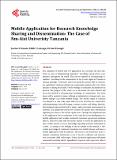| dc.description.abstract | The utilization of mobile and web applications has surpassed all other plat-
forms in terms of disseminating researchers’ knowledge among diverse com-
munities throughout the world. The current method of disseminating re-
searchers’ knowledge to the communities in the Arusha region in Tanzania is
through meetings, workshops, and focus group discussions held by research-
ers, agricultural extension officers and community members after every three
months or during field study. Yet the strategy is inefficient and ineffective in
practice. The purpose of this study was to determine the most efficient and
successful method of disseminating knowledge in communities. The study
began with a qualitative phase, utilizing an interpretive technique and a qua-
litative multiple case study research design. The Arusha region in Tanzania
was selected as a case study where different social activities were undertaken,
including farming, livestock keeping, tourism activities and fishing. Individu-
al participants were interviewed by using a semi-structured questionnaire. In
addition, focus group discussions were conducted to gather more information
regarding the needs of the mobile application. Through the implementation
of the application, the second phase of the study led to the development of a
mobile application that includes community members, agricultural extension
officers, and researchers that will enable anyone to install the application on
their mobile phones to access knowledge regarding activities undertaken in
Arusha. According to the findings of the first phase of the research, a sub-
stantial percentage of community members own mobile phones, and hence a
mobile application would be sufficient. The research also found that most re-
searcher-community interactions occur at the data collection and interven-
tion assessment (field trials) stages. Hence, the mobile application will benefit
community members, district agricultural, irrigation, and cooperative officers (DAICO), and researchers. | en_US |

